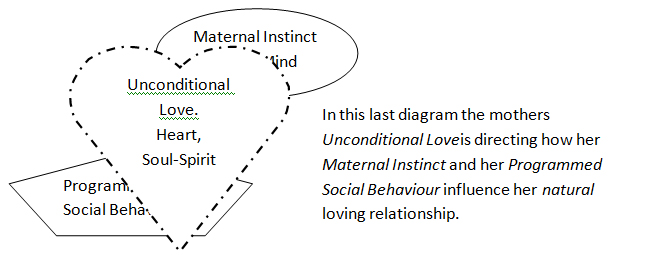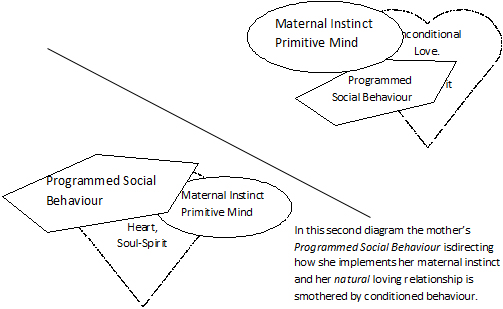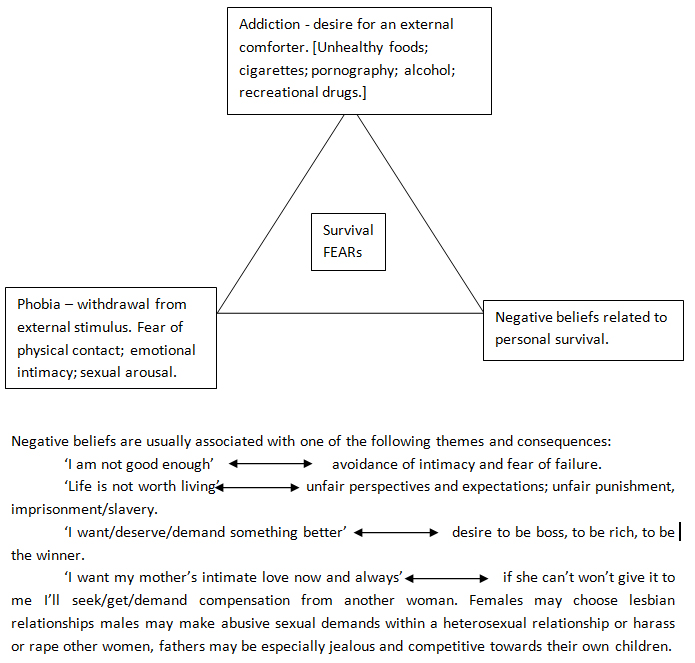 Maternal instinct appears to be nature’s way of trying to ensure that the mother takes responsibility for her new baby and helping her to accept the new demands placed upon her.
Maternal instinct appears to be nature’s way of trying to ensure that the mother takes responsibility for her new baby and helping her to accept the new demands placed upon her.
There are two aspects to maternal instinct:-
- The mother’s bond of loving and caring for the child.
- The mother’s acceptance of responsibility for the child.
However this is an instinct and is not therefore dependent upon conscious awareness or conscious decision making related to the individuality of the child’s personality and needs. An instinct is not organized by the mothers conscious will, it is more likely to the automatic responses directed by either intuition or subconsciously programmed responses based on primitive instinct, the mother’s own experience of being mothered, and/or automatic responses programmed by external social and emotional experiences. Mothers who wish to give their new infants a different upbringing to that which they had themselves, often find themselves still repeating what they consider to be their mother’s style of maternal care, including the very things they wanted not to present to their own baby. .
The diagrams below illustrate how the mother’s behaviour can be lead or dominated from different sources of control.
In the first diagram the mothers Maternal Instinct is strongly linked with Programmed Social Behaviour andthis is dominates over her natural loving relationship.


Maternal instinct is directly related to the birth mother and her baby and is not therefore necessarily seen when mother’s respond to babies that are not their own by birth. Some women may project their mothering instinct onto other babies. Others may be more naturally authentic in their caring or they may feel quite unattached or even indifferent. Sisters can often express maternal love towards their own and their sister’s baby. This would appear to be an extension of blood relationship required for maternal instinct to be activated. For example the author once found her breasts to be expressing milk at the time there was no explainable reason for this one-off event. However, later on she discovered that at that time her sister was unable to breastfeed her second child.
An awareness of how the three modes of care (illustrated above in the diagrams) are interacting and which is holding the strongest position is important if the mothers care is going to be related appropriately to the individuality of the infant and different situations. For example a sick or handicapped child may warrant extending the period of strong maternal instinct in order to encourage the mother to meet the extra demands on physical care and sacrifices related to her own freedoms. Teenage mothers may also need to hold onto the dominant maternal instinct especially during the early months when they feel the immaturity in their own life experiences and have a great social change to accommodate. Nevertheless for all mothers it would seem important to integrate these three modes of behaviour (illustrated in the diagrams) as consciously as possible, and consciously monitor when and for how long the maternal instinct is allowed to dominate the delicate development of the mother to child relationship.
Maternal instinct is governed by the subconscious mind and therefore mothers can find that it is acting against the child and or the mothers’ own best interests. For example the mother of a child with specific learning difficulties may project her success as a parent into that of her ability to compensate for the child’s difficulties. Her over endeavour can involve her helping the child so much that the child‘s natural development through play is suppressed. Physically handicapped children are often denied opportunities to keep on trying when the result is unlikely to be successful, e.g. a normal child may attempt to do up his laces many times unsuccessfully before achieving only the first step. To learn the whole process may take a lot of practise and repeated failure at each stage of the task. Even when the individual steps have been mastered, failure to hold all the stages consecutively as one coordinated operation may mean the bow remains too loose to function properly. The mother of a blind child may never encourage the child to do up laces. However, most adults who have mastered this skill can do it with their eyes closed and the blind child’s development of kinaesthetic skills is going to be critical to their independence and self-directed learning. The very task of doing up laces may therefore be very beneficial to practise with supportive adult scaffolding, no matter how long it takes for the initial learning to be successful. One could therefore consider that the special child’s difficulty warrants more careful assistance and a great deal more opportunity to practise, whereas in most cases these children get less suitable help and encouragement to practise than that offered to a ‘normal’ child. This completely denies the special child the extra support and repeated practise that is required for any level of associated learning.
| If I loved sharing your life more than I loved living my own life then the waters of a sharing relationship would remain rather shallow. For love is bound to wither if a relationship does not encourage each person to love their own life, and expand this gift creatively into a richer and deeper everyday love of life. |
These examples illustrate how maternal instinct can remain dominant for a prolonged period and thereby cause the mother to act subconsciously against the child’s natural maturity and individual empowerment. I love my life more than I love you and your life and my love of life is the measure of how I can share lovingly with you.
The author noted that when a mother of an autistic child saw him developing normally she said “What do I do if he is not autistic” and abandoned the successful intensive programme (Option Institute –Son Rise ) with his private teacher and placed him in a special unit for autistic children. This mother held the intensive level of care needed for her severely autistic child so intensely that she had forgotten how to live her own life for herself. Much of the obvious success in overcoming his autism was subsequently lost; however, he never regressed right back to his original level of autistic disability. This extreme real life example has been seen by the author in many different circumstances.
For some mothers a subconscious programme of over protection motivates them to subconsciously sabotage the child’s natural development. This keeps the child predominantly dependent upon the mother for their safety and wellbeing. This subconscious programme has sometimes been cleared by a therapeutic approach that heals the mother of subconsciously retained emotions of grief. This grief may be related to their own experience e.g. abortion, miscarriage, death of a sibling, or a grief passed down from their own mother when they were themselves a young baby.
In some situations it appears that the situation can be reversed. When the maternal instinct is not activated subconsciously a mother may experience one of the following dispositions:-
- She cannot give up her own career/lifestyle in order to care for her child.
- She loves her own children and all other children as best she can, within the constraints of her own personal needs and circumstances
- She accommodates children as individuals who may be offering a relationship. She chooses to engage all children with an authentic or spontaneous response unrelated to social expectation and external judgment.
- She loves all children unconditionally and offers them heart-full care.
The options above illustrate that a woman may not necessarily be dependent upon her maternal instinct to motivate how she responds to her own biological children or any other child with whom she has a genuine relationship.
“The greatest strength of women lies in their innate motherhood, in their creative, life giving power…….men still have a great deal of resistance when it comes to properly understanding, accepting and recognizing women and the feminine aspects of life…..The essence of motherhood is not restricted to women who have given birth, it is a principle inherent in both women and men. It is the attitude of mind. It is love – and that love is the very breath of life.” (The Awakening of the Universal Mother spoken by Sri Mata Amritanandamayi Devi Oct 7th 2002 at the Global Peace Initiative of Woman Religious and Spiritual Leaders)
A LIFETIME…………?…!!
In a blink of an eye a lifetime is gone.
As the sorrows and hardships drop into oblivion.
The joys and celebrations blow through the heavens.
Gratitude and love for each other unites in the divine realm forever.
So be it and let’s do it again
Praise to the new birth,
The Baby bliss.
Childhood adventures,
Soulful relationships,
And the companionship of god’s unconditional love.
The empowerment of creating my own reality,
The stories of devotion and service.
The following diagram illustrates the detrimental aspects associated with imbalance related to

Excessive and prolonged levels of maternal instinct can distract the mother from consciously evaluating the best interests of the child. Mother-child co-dependence can create resistance to the natural weaning process such that the child is always wanting to be fed on demand, and reluctant to sleep separately from the mother. As the mother tries to wean the child off of breast milk and body contact during sleep the child may focus his/her behaviour on alternative demands for one to one attention, excessive levels of physical intimacy, external entertainment, material comforts and ultimately money. Thus, the natural development of independence associated with weaning and sleeping can be substituted by demanding behaviour from the child that gives him or her adverse powers of manipulation and abusive behaviour associated with intimacy.
Unresolved resentment around issues related to separation form the mother due to weaning and separate sleeping experiences can be associated with later mental issues of addiction or phobia in the adult.

The primitive nature of the maternal instinct can thereby become so compulsive that as the child grows the mother becomes a slave to the child’s demands and ultimately victim to the child’s abusive demanding behaviour. This can in turn incite parent abuse projected through physical domination, over-whelming issues of control or sexual perspectives either imaginary or physical. For example: a mother may relate to a boy child as if he was her male partner or lover. In response her son may relate to his mother as a life-long partner and later look to her for sexual pleasures.
Alternatively an over-protective father may dote on his daughter as his beloved and this may incite her into early womanhood and sexual activity. When this is projected out into the world the father may become intensely jealous and his over-protective fatherly discipline can then easily become exaggerated into forms of abuse. The daughter may find her only consolation and escape is through intimate comfort and possibly sexual activity with a trusted male relative or a trusted male family friend. Sometimes the daughter will be desperate to gain affection from a boy of her own age, and secretly attain a boyfriend and be quick to experience sexual intimacy and possible pregnancy.
Motherhood is a test that highlights our own relationship with life and thus we are challenged to find a way to maintain a healthy balance on the scales of motherhood that are loaded with love and responsibility beyond ourselves.
| ‘For I was hungry and you gave me food, I was thirsty and you gave me drink, I was a stranger and you welcomed me , I was naked and you clothed me, I was sick and you visited me, I was in prison and you came to me. Then the righteous will answer him saying, ‘Lord, when did we see you hungry and feed you, or thirsty and give you drink? And when did we see you sick or in prison and visit you? And the King will answer them, ‘Truly , I say to you, as you did it to one of the lease of these my brothers, you did it to me.’ Matthew 25:35-40. (Crossways English Standard Version, Study Bible.) |
